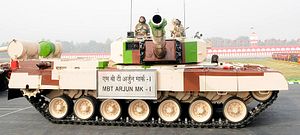Last week, India’s Ministry of Defense (MoD) invited responses by December 20 to it global request for information (RFI) to develop and build 1,770 armored fighting vehicles to replace the Indian Army’s aging force of T-72 main battle tanks (MBTs).
The Indian Army is looking to procure the new so-called Future Ready Combat Vehicles (FRCV) under the Strategic Partnership model in collaboration with an Indian partner. India’s MoD issued a similar RFI already in June 2015.
The new FRCV system will serve as a platform for as many as 11 different tracked vehicles, including light tracked, wheeled, bridge layer and trawl tanks, self-propelled howitzers (SPH), air defense guns, artillery observation post and engineering reconnaissance vehicles, and armored ambulances.
Most importantly, however, it will be the base platform for India’s next indigenously designed and build MBT.
The FRCV “is proposed to be a Medium Weight Class Tank, incorporating ‘state-of-the-art’ technologies, and will remain relevant for the next 40-50 years,” the RFI reads. The new MBT should be equipped with a 120/125 millimeter main gun (firing 6-8 rounds per minute), coaxial machine guns, as well as an anti-aircraft machine gun. The tank’s main gun should also be capable of firing multiple types of ammunition including advanced anti-tank guided missiles.
The FRCV also should boast the “capability to destroy enemy tanks at ranges higher (…) with very high first round hit/kill probability and acquire targets at a longer range.” It should also be capable of engaging low flying manned and unnamed rotary wing aircraft.
The new FRCV is intended for “rapid dominance in an expanded battle space, characterized by real time awareness, all terrain agility and high mobility, precision lethal firepower, multi-layered protection and increasing use of technology,” the RFI reads. “The Future Ready Combat Vehicle will be required to conduct sustained, continuous operations by day and night in all terrain, in various forms where applicable (except in an amphibious role).”
A request for proposal (RFP) is likely to be issued in the middle of 2018. The Indian Army is especially interested in keeping the weight of the tank at around 50 tons (plus or minus 15 tons, according to the RFI), which will exclude heavier foreign MBTs (e.g., the German Leopard II and U.S.-made M1-Abrams) from competing in the global tender. According to some media reports, the Indian MoD will especially look at four foreign MBT models: the Russian T-14 Armata, the Ukrainian T-84 Oplot, the French Le Clerc, and the South Korean K2 Black Panther.
What I argued in June 2015 still holds true today:
The recent RFI could also very well ring the final death-knell for India’s indigenously developed third generation Arjun MK-I main battle tank – a poorly designed vehicle (e.g., too much heavy armor versus too little horsepower) that encountered repeated delays due to a flawed procurement and testing process. Almost eighty percent of the 124-strong Arjun MK-I tank force is currently grounded due to more than 90 technical issues.
India has been working on an improved version of the Arjun, the MK-II, which has done very well in comparative trials with license-built Russian tanks such as the T-90M. It displays more than 93 improvements over the older version and contains 60 percent locally manufactured components. However, a decision to indigenously develop a new anti-tank missile to be fitted onto the MK-II will, in all likelihood, delay the induction of the upgraded platform.
The Indian Army refuses to order the MK-II until it passes field trials. “The FRCV project, if it takes off, will kill the indigenous FMBT project,” a Defense Research and Development Organization (DRDO) engineer told The Times of India last week.

































